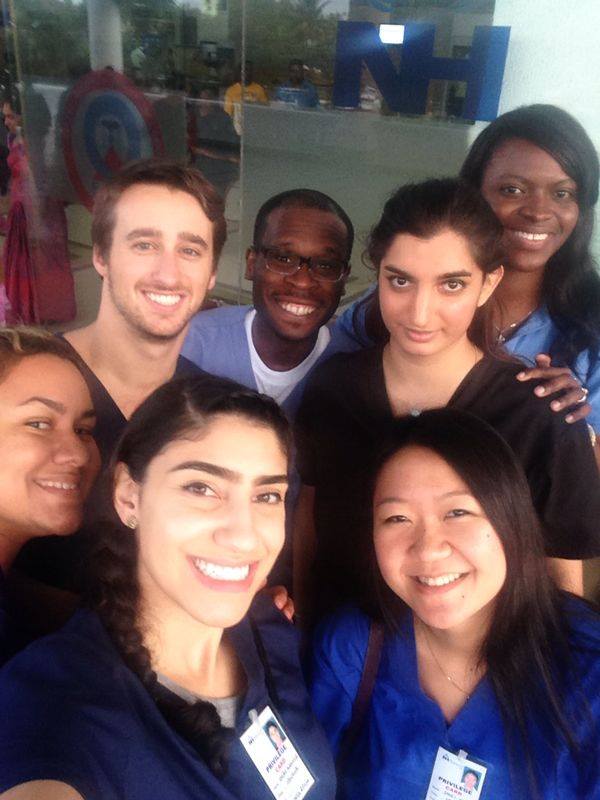India, Here We Come!
This past winter break, TouroCOM-Harlem students embarked on a mission to Narayana Health City in India.

This winter break, Smruti Desai (OMS-II) organized a trip of fourteen first- and second- year Touro College of Osteopathic Medicine (TouroCOM-Harlem) students to Narayana Health City in Bengaluru, India through TouroCOM’s International Medicine Club.
For one week, each Touro student on the trip rotated though a different department in Narayana’s main hospital, including the department of oncology, nephrology, critical care, cardiology, pediatric cardiology, cardiac surgery, endocrinology, and general surgery.
Read second-year student Gayatri Malhotra-Gupta’s account of the trip:
"With a population of over 1.2 billion people, India is the second largest country in the world. An estimated 600 million Indians have little to no access to adequate healthcare. Poverty has left the largely rural population with little access to power or clean water, impacting hygiene and causing a high rate of infectious disease. India also has one of the highest rates of infant mortality.
With these challenges in mind, Dr. Devi Shetty, an Indian philanthropist and cardiac surgeon, established Narayana Health in 2000. A tertiary care, multi-specialty health service group with a world-renowned cardiology center, Narayana Health has grown to be one of the largest in India. With 7500 beds in 29 hospitals, Narayana Health Group promises that “no one is refused treatment due to lack of funds.”
My first day was spent in the hematology/oncology department with the residents who took us on rounds. Fellow student Matthew Woodward (OMS-II) and I first visited the men’s ward, which was comprised of about ten patients. We observed an HIV patient with a B-cell lymphoma that had grown so large so quickly that it obstructed his eye in a month. As with all of the inpatients, Matthew and I were able to go through his patient charts along with his lab results. In the woman’s ward we met a patient with Dengue fever, a relatively common illness in India usually treated by platelet donations. However, since the patient was a religious Jehovah’s Witness Christian, she could not accept blood transfusions and was being managed as an inpatient with other treatment options.
Later, we observed a valvuloplasty by balloon catheter for a patient with mitral valve stenosis. Mitral valve stenosis, a condition in which the heart’s mitral valve is blocked or narrowed, usually is caused by rheumatic heart disease – a disease that is still quite common in developing countries.
Patients had travelled from all parts of India, and even from foreign countries, to receive treatment in Narayana’s Mazumdar-Shaw Cancer Center. We met a girl from Delhi who was recovering from her cancer treatment. The doctors were explaining to her mother that they needed to test a lesion on her lung to see if it could be Tuberculosis. Her current steroid treatment had left her with Cushingoid symptoms—she had moon facies, sarcopenia, and a buffalo hump. She started telling the doctors that she was scared. She said she had dreamt one night that someone was pulling on her ears. The chief resident used some humor to comfort her while explaining to her that the test needed to be done for her safety. It was striking to see how most doctors were able to transition from local dialects to Hindi to English to communicate with their different international patients.
On my last day at Narayana Health City, the waiting room for the pediatric cardiology department was packed even before any doctors had arrived in the morning. Janet Hong (OMS-II) and I were placed in a room with three fellows, two of whom were Ethiopians training at the hospital. Since the Ethiopian doctors did not speak any Indian languages, I translated for them from English to Hindi so that they could obtain accurate patient histories.
The lead doctor then did a physical exam, listening to the heart sounds and pulses of each patient. Janet and I were given the opportunity to administer physical exams on these children as well. One of the patients was a 12-year-old boy from Bangladesh who had Marfan’s Syndrome, a genetic disorder that affects the body’s connective tissue. The boy had a palpable thrill and bounding pulses in his heart. We also met a 10-year-old girl with Tetralogy of Fallot, a congenital heart defect. She had cyanosis in her fingers and showed us how she squatted to be more comfortable. Though cardiac abnormalities in Tetralogy are usually surgically corrected in infants, this girl was still waiting for her surgery due to her family’s poverty.
This is just a small snapshot of what we saw throughout the week. Aside from our incredibly inspiring hospital experience, our group was able to explore and enjoy the rich culture that Bengaluru has to offer: We took a trip together to the beautiful Mysore palace, visited a nearby temple, and enjoyed eating spicy masala dosas.
The trip was truly eye-opening in many aspects."
--Gayatri Malhotra-Gupta, OMS-II

